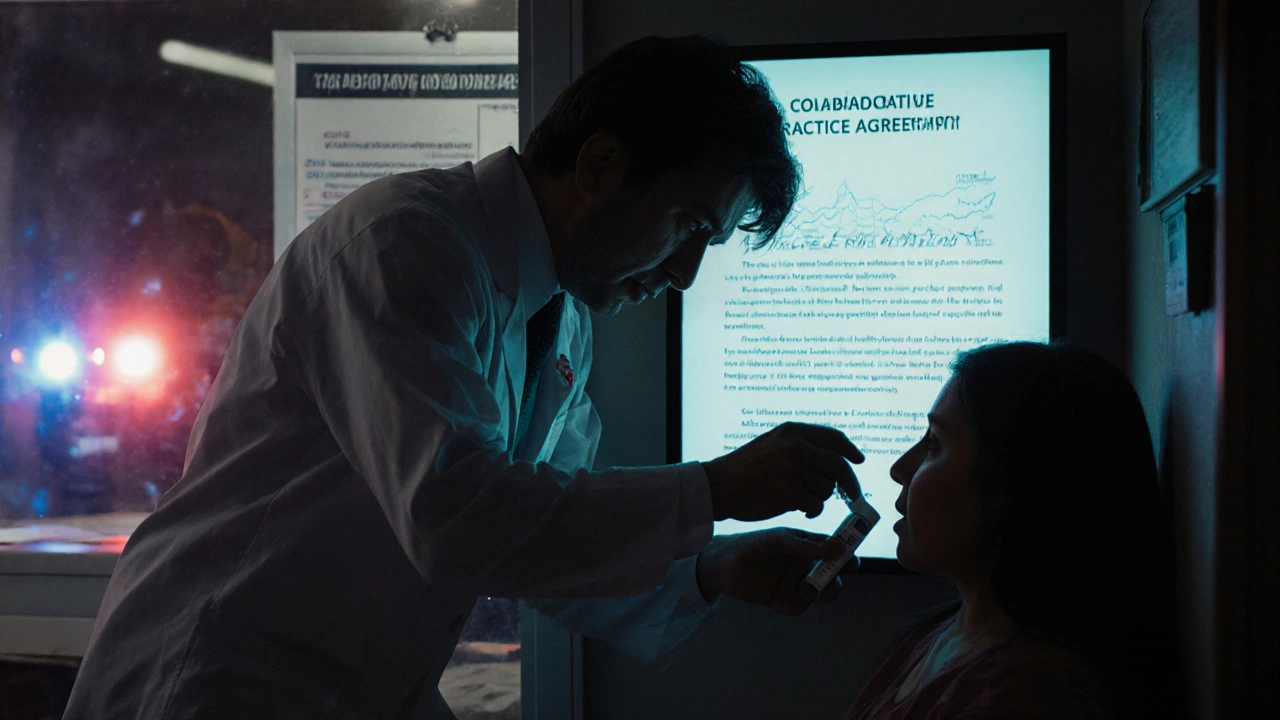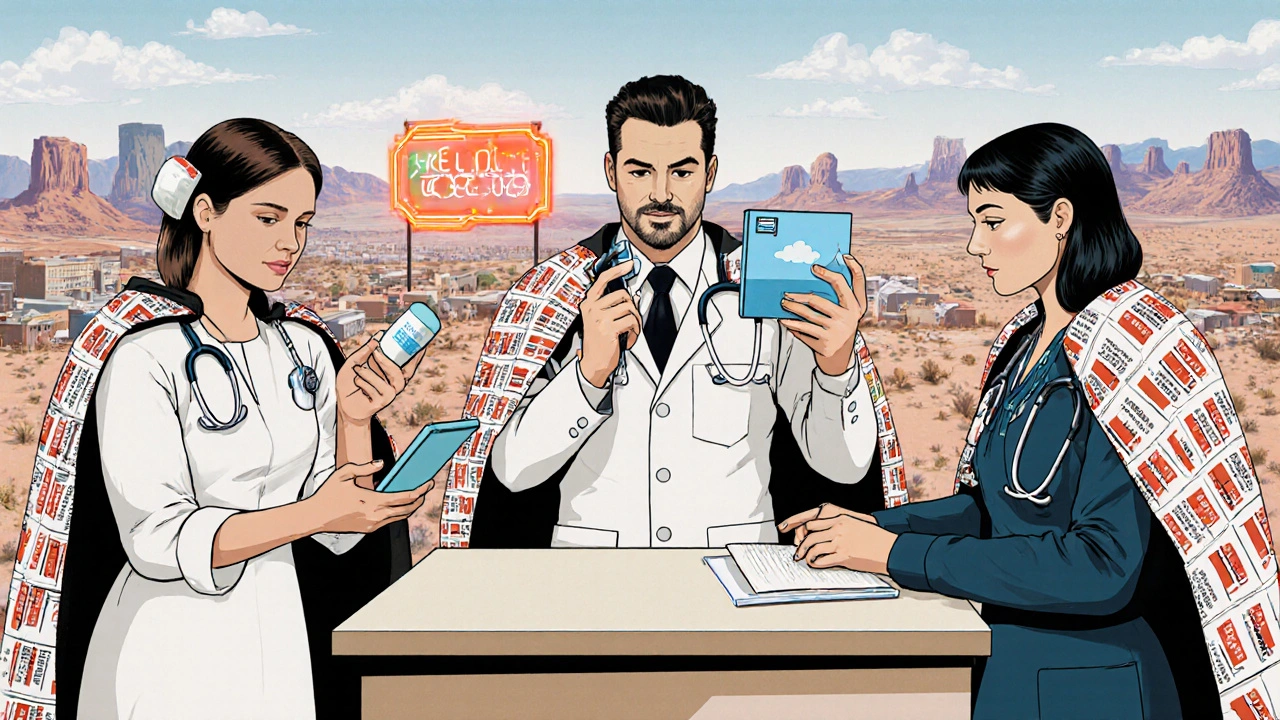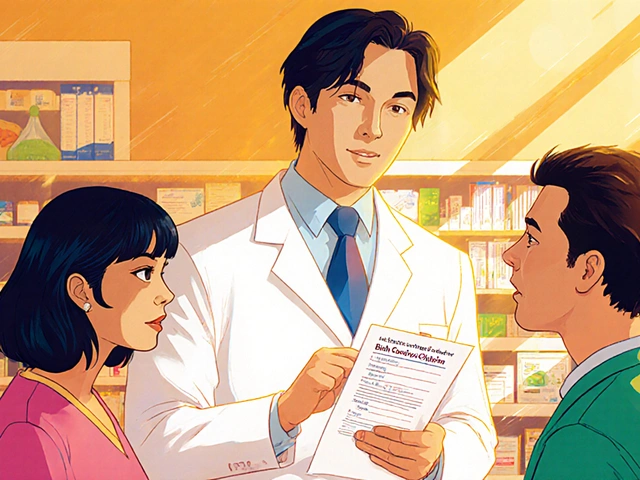For decades, pharmacists were seen as the people who handed out pills with a quick word of advice. But today, in many parts of the U.S., they’re doing far more - adjusting prescriptions, prescribing birth control, dispensing naloxone without a doctor’s note, and even running basic health screenings. This shift isn’t accidental. It’s the result of decades of legislative change, workforce shortages, and a growing recognition that pharmacists are among the most accessible healthcare professionals in the country. Understanding pharmacist substitution authority means understanding how the role of the pharmacist has changed - and where it’s headed next.
What Exactly Is Pharmacist Substitution Authority?
Pharmacist substitution authority isn’t one thing. It’s a collection of legal powers that let pharmacists make changes to prescriptions without going back to the prescriber. These powers vary by state, but they generally fall into four categories: generic substitution, therapeutic interchange, prescription adaptation, and independent prescribing.
Generic substitution is the most basic form. In every state, if a doctor writes a prescription for a brand-name drug like Lipitor, the pharmacist can swap it for the generic version, atorvastatin - unless the doctor specifically writes "dispensed as written." This is standard practice. It saves patients money and reduces healthcare costs. But it’s just the starting point.
Therapeutic interchange goes further. Instead of swapping one chemical for another identical one, pharmacists can switch to a different drug in the same class. For example, if a patient is on lisinopril for high blood pressure, a pharmacist in Arkansas, Idaho, or Kentucky could switch them to losartan - if the prescriber has marked the prescription with "therapeutic substitution allowed." These states require pharmacists to notify the prescriber and explain the change to the patient. It’s not a free-for-all. It’s a structured, documented process designed to improve outcomes while keeping the original prescriber in the loop.
How States Are Expanding the Role
Some states have taken bolder steps. Maryland lets pharmacists prescribe birth control to adults without a doctor’s involvement. Maine allows pharmacists to dispense nicotine replacement therapy for smoking cessation. California uses the word "furnish" instead of "prescribe," giving pharmacists legal cover to provide specific medications under standardized protocols.
New Mexico and Colorado have gone even further. They’ve created statewide protocols managed by their boards of pharmacy. These protocols allow pharmacists to provide certain medications - like flu shots, emergency contraception, or epinephrine auto-injectors - without needing individual prescriber approval for each case. If a patient walks in and meets the criteria, the pharmacist can act. No phone call. No waiting. No extra visit.
Collaborative Practice Agreements (CPAs) are another major tool. All 50 states and D.C. allow these written agreements between pharmacists and physicians. They spell out exactly what the pharmacist can do: adjust insulin doses, start anticoagulants, manage asthma inhalers, or order lab tests. The level of autonomy varies. In some places, the physician still needs to sign off on every change. In others, the pharmacist runs the protocol with minimal oversight - especially in rural clinics where doctors are scarce.
Why This Matters: Access and Equity
The push for expanded authority isn’t about pharmacists wanting more power. It’s about patients needing better access.
According to the Health Resources and Services Administration, 60 million Americans live in areas with a shortage of healthcare providers. In rural towns, the nearest doctor might be 50 miles away. A patient with high blood pressure can’t afford to drive there every month for a refill. But the local pharmacy? It’s open evenings. It’s on the bus route. It’s where people already go for flu shots and cholesterol checks.
Prescription adaptation laws let pharmacists tweak a dose or switch a medication for someone who can’t get to their doctor. In states like Kentucky and Illinois, this is written into law. The pharmacist reviews the patient’s history, checks for interactions, and makes a change - then notifies the prescriber. No one loses care. Someone gains convenience.
Emergency access matters too. Pharmacists can now dispense naloxone - the opioid overdose reversal drug - without a prescription in nearly every state. That’s saved lives. In places like Ohio and West Virginia, where overdose rates are high, pharmacists are on the front lines of the crisis.

The Big Hurdle: Reimbursement
Just because a pharmacist can prescribe doesn’t mean they get paid for it. This is the biggest roadblock.
Medicare, Medicaid, and private insurers still don’t consistently recognize pharmacists as providers. A pharmacist in Maryland who prescribes birth control can’t bill Medicaid for the service unless the state has a specific reimbursement code. Many states don’t have those codes. Even when they do, insurance companies often refuse to pay, calling it "pharmacy dispensing" rather than "clinical service."
This is why the federal Ensuring Community Access to Pharmacist Services Act (ECAPS) is so important. If passed, it would require Medicare Part B to cover services like screenings, vaccinations, and medication management provided by pharmacists. That’s not just about money - it’s about legitimacy. If Medicare recognizes pharmacists as providers, private insurers will follow.
Opposition and Concerns
Not everyone supports this shift. The American Medical Association has long argued that pharmacists don’t have the same training as physicians. They worry about fragmented care, misdiagnosis, or patients being steered toward cheaper drugs without proper evaluation.
There’s also concern about corporate influence. Large pharmacy chains like CVS and Walgreens have pushed hard for expanded scope - and they stand to profit from more services. Critics say this turns healthcare into a retail transaction.
But data tells a different story. Studies show that when pharmacists manage chronic conditions like diabetes or hypertension, patients have better outcomes. Blood pressure control improves. Cholesterol levels drop. Hospitalizations go down. In a 2022 study of over 10,000 patients in community pharmacies, those under pharmacist-led care had 30% fewer emergency visits for asthma and COPD flare-ups.
The real issue isn’t training. It’s integration. Pharmacists need to be part of the care team, not just the last stop on the prescription line. Shared electronic health records, clear communication channels, and standardized protocols are what make this work - not just legal authority.

What’s Next?
In 2025 alone, 211 bills were introduced across 44 states to expand pharmacist scope. Sixteen have already passed. The trend is clear: pharmacists are becoming clinical providers.
Look ahead, and you’ll see more states adopting statewide protocols. More CPAs with pharmacist-led decision-making. More reimbursement codes. More integration with primary care teams.
The future isn’t about pharmacists replacing doctors. It’s about them working alongside them - filling gaps, reducing wait times, and bringing care closer to where people live. In a country with a looming shortage of 124,000 physicians by 2034, that’s not just helpful. It’s necessary.
What Patients Should Know
If you’re on a long-term medication, ask your pharmacist: "Can you adjust my dose if needed?" If you need birth control, nicotine patches, or naloxone, ask if you can get it without a doctor’s visit. You might be surprised.
Know your rights. In states with therapeutic interchange, you can refuse a substitution. In states with prescribing authority, you’re entitled to an explanation of why the change was made. Keep your medication list updated - whether it’s in your phone, your wallet, or with your primary care provider.
Pharmacists aren’t just handing out pills anymore. They’re managing your health. And you don’t need to wait for a doctor’s appointment to talk to them about it.
Can a pharmacist change my prescription without my doctor’s permission?
It depends on your state and the type of change. All 50 states allow pharmacists to swap brand-name drugs for generic versions unless the doctor says "do not substitute." Some states let pharmacists switch to a different drug in the same class (therapeutic interchange), but only if the prescriber has marked the prescription to allow it. In states with collaborative practice agreements or statewide protocols, pharmacists can adjust doses or even start new medications - but only under strict rules, and they must notify your doctor afterward.
Which states let pharmacists prescribe birth control?
As of 2025, Maryland, California, Oregon, Washington, New Mexico, Colorado, Nevada, and Illinois allow pharmacists to prescribe birth control to adults without a doctor’s prescription. Most require patients to be over 18 and complete a brief health screening. Some states require pharmacists to enter the prescription into the state’s prescription drug monitoring program.
Do pharmacists need special training to have prescribing authority?
Yes. States that allow independent prescribing or therapeutic interchange require additional training beyond the standard Pharm.D. degree. This often includes certification in clinical pharmacology, patient assessment, and emergency protocols. Many states also require pharmacists to complete continuing education credits every year to maintain their expanded privileges. In some cases, pharmacists must pass a state-specific exam.
Can I refuse a substitution made by my pharmacist?
Absolutely. In every state, you have the right to refuse any substitution - whether it’s a generic version or a different drug in the same class. Pharmacists are required to explain the change, tell you why it’s being suggested, and confirm that you’re okay with it. If you say no, they must fill the original prescription as written.
Why don’t insurance companies always pay pharmacists for prescribing services?
Most insurance systems still classify pharmacists as dispensers, not providers. Even if a pharmacist prescribes a medication, insurers often only reimburse for the cost of the drug, not the time, assessment, or counseling that went into it. This is changing slowly, but without federal action - like the ECAPS bill - reimbursement remains inconsistent. Some states have created specific billing codes, but many don’t, leaving pharmacists unpaid for valuable clinical work.
How do collaborative practice agreements work?
A collaborative practice agreement is a written contract between a pharmacist and one or more physicians. It outlines exactly what the pharmacist can do - like adjusting blood pressure meds, starting anticoagulants, or ordering lab tests. It also says when the pharmacist must refer the patient back to the doctor. These agreements are legally binding and must be registered with the state board of pharmacy. They’re common in rural clinics, nursing homes, and chronic disease management programs.




Neoma Geoghegan
November 24, 2025 at 12:46Pharmacists are the real MVPs of primary care. No more waiting weeks for a doc. Just walk in, get your script adjusted, and go. This is healthcare that works.
Bartholemy Tuite
November 25, 2025 at 02:58Man i been goin to my local pharmacy for years and they’ve been doin way more than just handin out pills. Last time i had a bad rash they gave me a topical steroid and told me to come back if it didn’t clear up. No doc visit. No insurance hassle. Just straight up care. They’re basically unsung docs with white coats. Why the hell are we still actin like they’re just cashiers?
Sam Jepsen
November 26, 2025 at 12:23As a Canadian, I’ve seen this model work for years. Pharmacists here can prescribe for minor ailments, renew scripts, even do point-of-care testing. It’s efficient, it’s safe, and it saves the system millions. The US is finally catching up - and honestly? It’s about damn time. Let pharmacists practice at the top of their license.
Yvonne Franklin
November 26, 2025 at 19:14Therapeutic interchange works if the pharmacist is trained and the system supports it. In states with protocols, outcomes are better. No magic. Just smart policy. Stop treating pharmacists like clerks.
Justin Daniel
November 26, 2025 at 20:02Wow. So now pharmacists are doctors? Just kidding. Sort of. I mean… if my pharmacist can prescribe birth control and adjust my BP meds, why does my doctor still charge $300 for a 10-minute visit? The system’s broken, not the pharmacists.
Melvina Zelee
November 28, 2025 at 19:24i think this is beautiful honestly. people forget that pharmacists are the most accessible health pros out there. you can walk in at 9pm with a headache and get advice. no appointment. no waiting. no judgment. why are we still clinging to this 1950s model where only MDs can do anything? it’s not about replacing docs. it’s about not making people suffer because of bureaucracy.
ann smith
November 28, 2025 at 23:38This is such a positive shift. Pharmacists are trained, licensed, and often more available than primary care providers. I’ve had my blood pressure checked at the pharmacy for years - and they caught a dangerous spike before I even noticed symptoms. 🙏 Let’s support their expansion - patients win.
Patrick Marsh
November 29, 2025 at 21:41Reimbursement is the real issue. They can prescribe, but they can’t bill. That’s not a policy gap - that’s a systemic betrayal.
Danny Nicholls
November 30, 2025 at 12:20Yessss this is the future 🙌 I got my flu shot, my asthma refill, and a quick BP check all in 15 mins at CVS. No doc. No wait. Just good care. Let’s make this national. Pharmacist power!! 💪💊
Robin Johnson
December 1, 2025 at 23:04Let’s not pretend this is all altruistic. CVS and Walgreens pushed this hard because it’s profitable. They’re turning pharmacies into clinics - and patients are the ones who benefit. But we need transparency. Who’s really calling the shots?
Latonya Elarms-Radford
December 3, 2025 at 09:10Oh here we go again. The great pharmacist revolution. The myth of the omniscient pharmacist. Who trained them? Who monitors their decisions? Who ensures continuity? This isn’t empowerment - it’s the dismantling of the medical hierarchy under the guise of convenience. We’ve traded rigorous care for retail efficiency. And now we’re calling it progress? What happens when the pharmacist misses a drug interaction because they’re busy ringing up cough syrup? Who’s accountable then? The patient? The pharmacist? The corporation? This isn’t innovation - it’s negligence dressed in a lab coat.
Mark Williams
December 3, 2025 at 17:42CPAs + statewide protocols = clinical integration at scale. The data is clear: pharmacist-managed anticoagulation reduces INR variability by 40%. That’s not anecdotal - it’s pharmacoeconomic. We’re not just filling scripts. We’re managing disease states. The system just hasn’t caught up with the evidence.
Daniel Jean-Baptiste
December 4, 2025 at 05:19love that this is happening. my cousin in bc gets her insulin adjusted by her pharmacist every 3 months. no doctor visit. no delay. just better control. why cant all states do this? its not rocket science. its just common sense.
Ravi Kumar Gupta
December 5, 2025 at 18:12In India, we have pharmacists who write prescriptions for minor infections - and they’re trained, licensed, and trusted. Why is the U.S. still arguing about this? We’ve been doing this for decades. Pharmacists are not clerks. They’re clinicians. Stop the colonial mindset. Adapt.
Rahul Kanakarajan
December 7, 2025 at 14:14Pharmacists prescribing? That’s just corporate greed pretending to be healthcare. Doctors go to school for 12 years. Pharmacists? 6. You think they can diagnose? Please. This is how you get patients on the wrong meds because some guy behind a counter is rushing to hit his daily quota. It’s dangerous. And someone’s gonna die because of it.